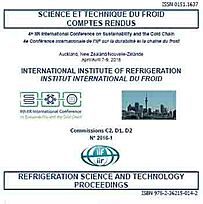
Document IIF
Comparaison de nature énergétique et environnementale des systèmes frigorifiques commerciaux fonctionnant au R744 sous des climats chauds.
Energy and environmental comparison of commercial R744 refrigeration systems operating in warm climates.
Auteurs : GULLO P., CORTELLA G., POLZOT A.
Résumé
Carbon dioxide (CO2, R744) is an environmentally friendly refrigerant, which is widely used in supermarket refrigeration systems located in cold weather sites. Its use at high outdoor temperatures still requires some additional investigations to accomplish performance similar to the one obtained by employing the conventional working fluids.
This paper deals with the theoretical comparison in terms of both annual energy consumption and Total Equivalent Warming Impact (TEWI) of different commercial R744 refrigeration cycles operating in five different warm climates. An innovative CO2 direct expansion (DX) configuration, which serves both the medium temperature (MT) load and the low temperature (LT) one, is also considered. Taking into account the running modes of a typical European supermarket and a R404A multiplex configuration as the baseline, the results showed that enhanced R744 refrigeration technologies are capable of dropping the energy consumption and the TEWI by at least 2.8% and 31.1%, respectively.
Documents disponibles
Format PDF
Pages : 9
Disponible
Prix public
20 €
Prix membre*
Gratuit
* meilleur tarif applicable selon le type d'adhésion (voir le détail des avantages des adhésions individuelles et collectives)
Détails
- Titre original : Energy and environmental comparison of commercial R744 refrigeration systems operating in warm climates.
- Identifiant de la fiche : 30017558
- Langues : Anglais
- Sujet : Environnement
- Source : 4th IIR International Conference on Sustainability and the Cold Chain. Proceedings: Auckland, New Zealand, April 7-9, 2016.
- Date d'édition : 07/04/2016
- DOI : http://dx.doi.org/10.18462/iir.iccc.2016.0041
Liens
Voir d'autres communications du même compte rendu (63)
Voir le compte rendu de la conférence
Indexation
-
R744 refrigeration technologies for supermarket...
- Auteurs : HAFNER A., HEMMINGSEN A. K.
- Date : 16/08/2015
- Langues : Anglais
- Source : Proceedings of the 24th IIR International Congress of Refrigeration: Yokohama, Japan, August 16-22, 2015.
- Formats : PDF
Voir la fiche
-
Energy and environmental performance assessment...
- Auteurs : GULLO P., ELMEGAARD B., CORTELLA G.
- Date : 04/2016
- Langues : Anglais
- Source : International Journal of Refrigeration - Revue Internationale du Froid - vol. 64
- Formats : PDF
Voir la fiche
-
System configurations for supermarkets in warm ...
- Auteurs : HAFNER A., HEMMINGSEN A. K., NEKSÅ P.
- Date : 02/08/2014
- Langues : Anglais
- Source : 11th IIR Gustav Lorentzen Conference on Natural Refrigerants (GL2014). Proceedings. Hangzhou, China, August 31-September 2, 2014.
- Formats : PDF
Voir la fiche
-
Worldwide performance of CO2 booster...
- Auteurs : LLOPIS R., CATALAN J., SÁNCHEZ D., NEBOT-ANDRÉS L., CALLEJA-ANTA D., CABELLO R.
- Date : 07/12/2020
- Langues : Anglais
- Source : 14th IIR-Gustav Lorentzen Conference on Natural Refrigerants (GL2020). Proceedings. Kyoto, Japon, December 7-9th 2020.
- Formats : PDF
Voir la fiche
-
Thermodynamic analysis of CO2 trans-critical bo...
- Auteurs : PUROHIT N., GUPTA D. K., DASGUPTA M. S.
- Date : 07/04/2016
- Langues : Anglais
- Source : 4th IIR International Conference on Sustainability and the Cold Chain. Proceedings: Auckland, New Zealand, April 7-9, 2016.
- Formats : PDF
Voir la fiche
